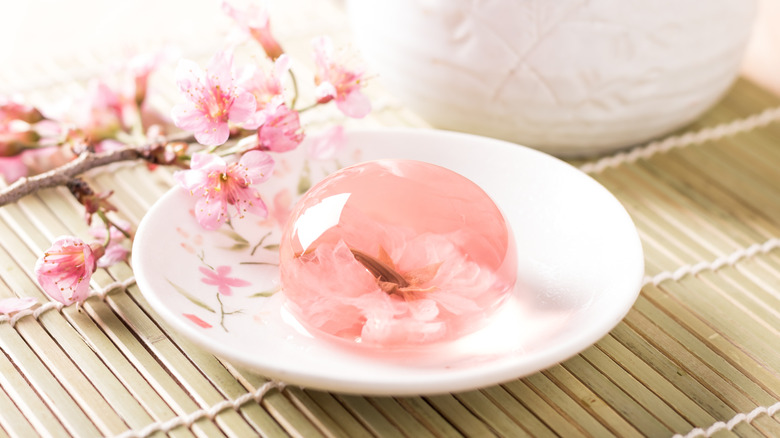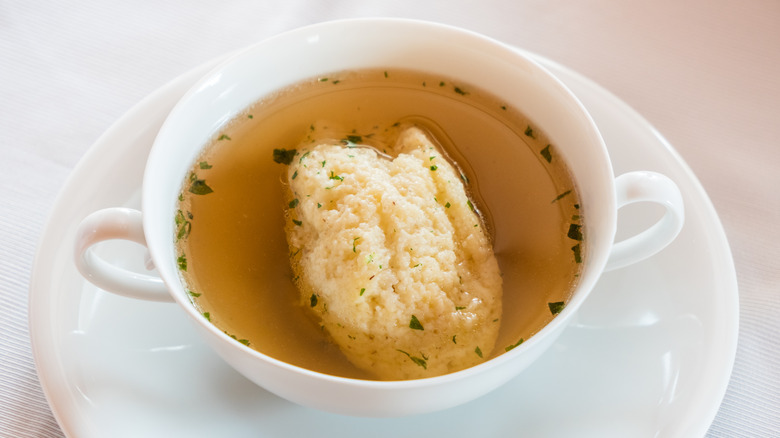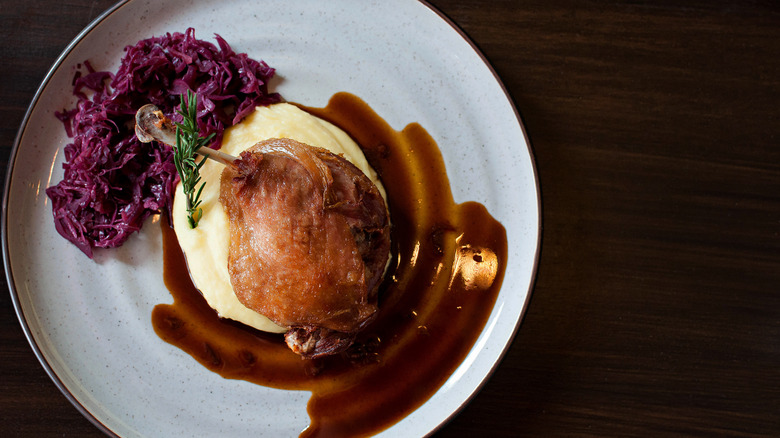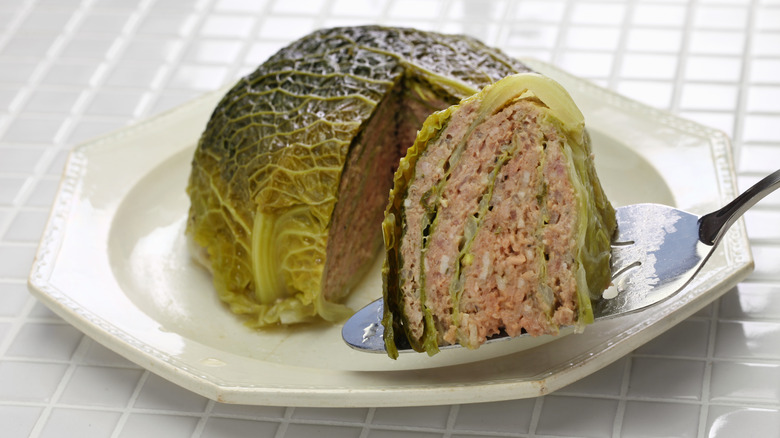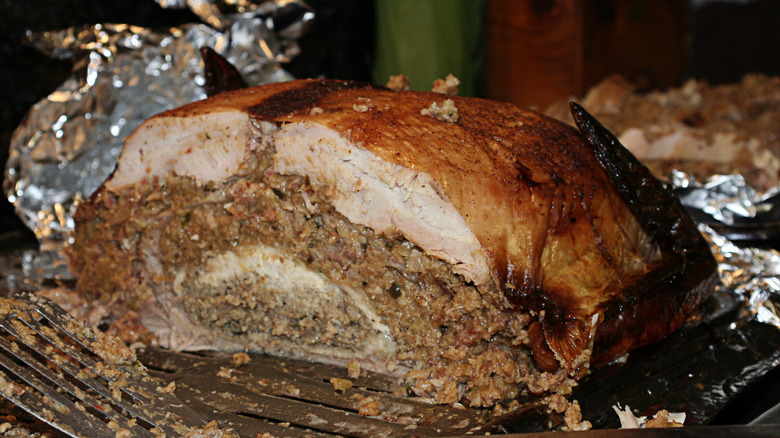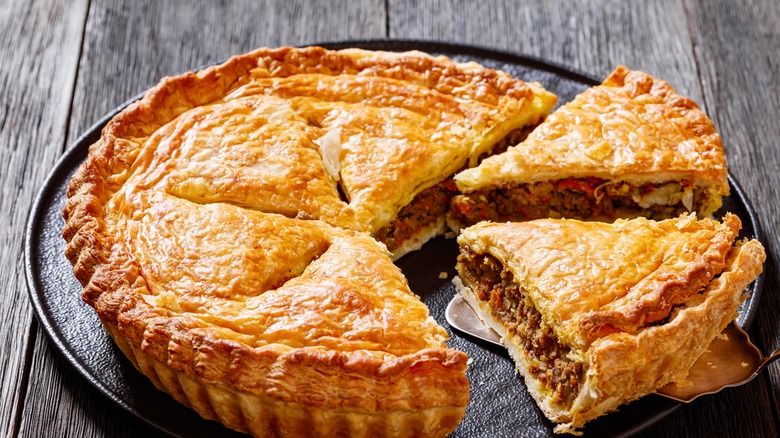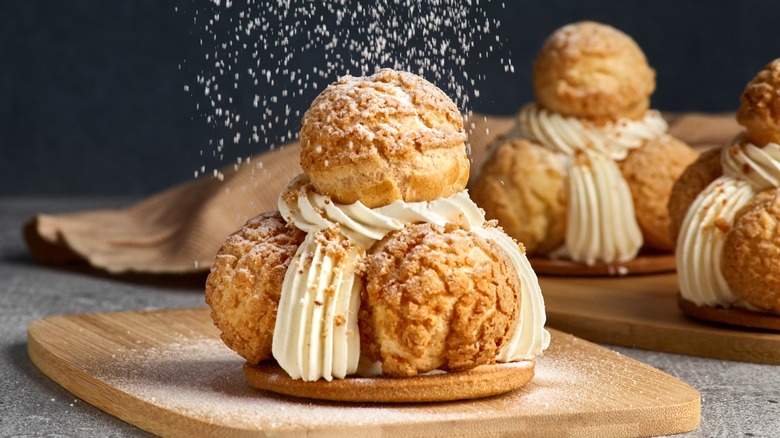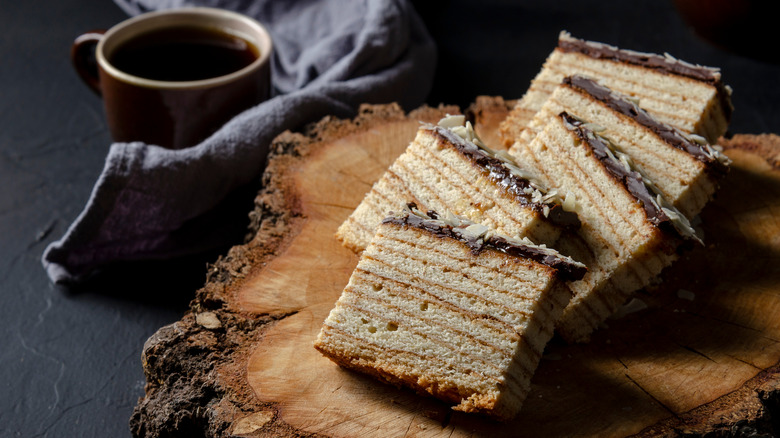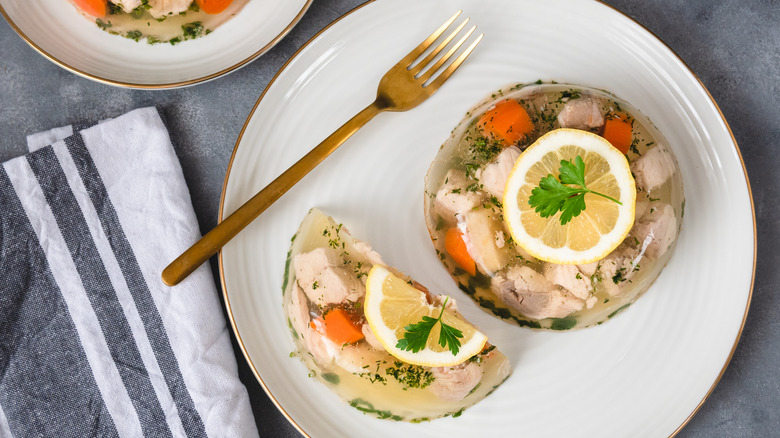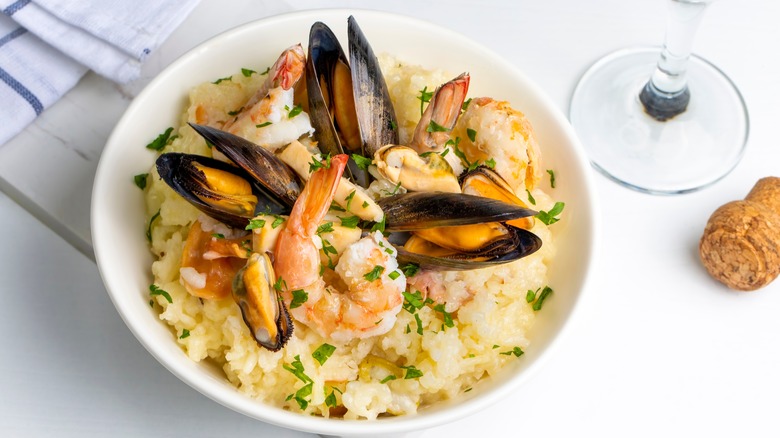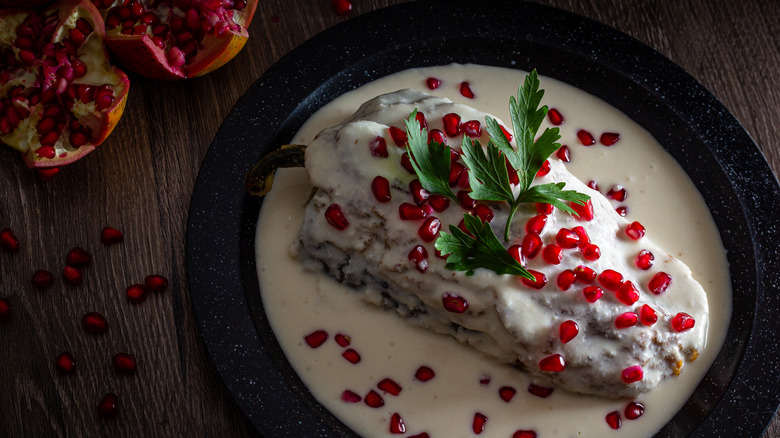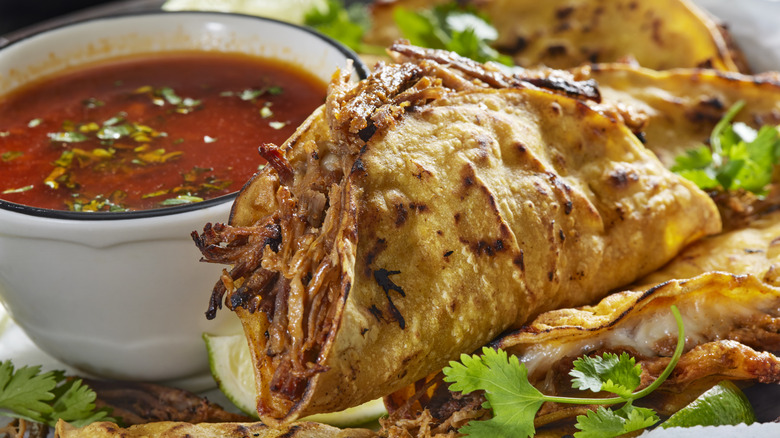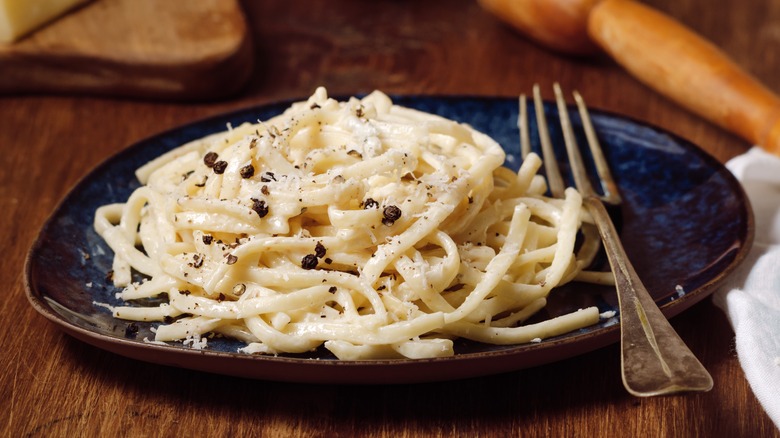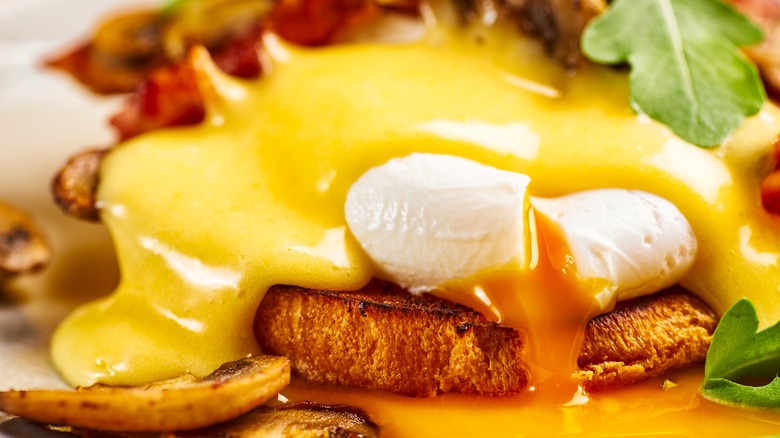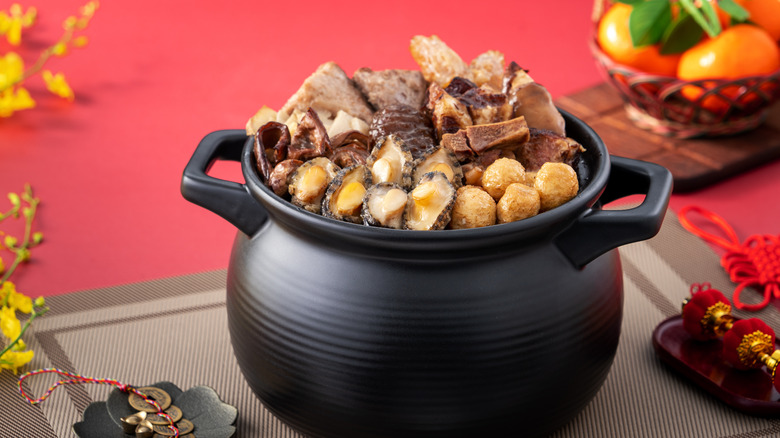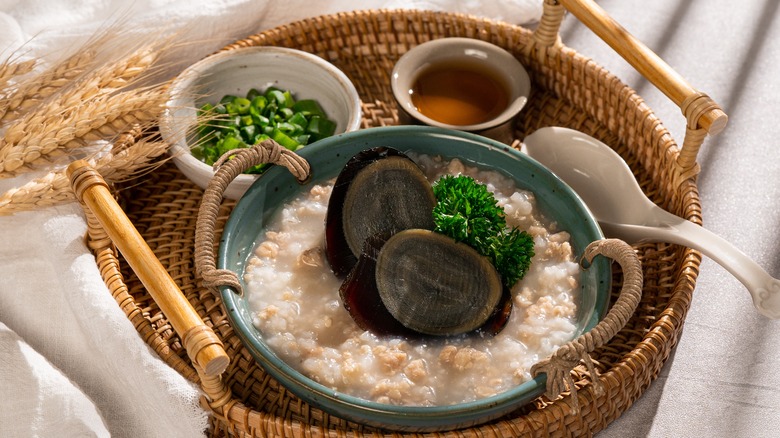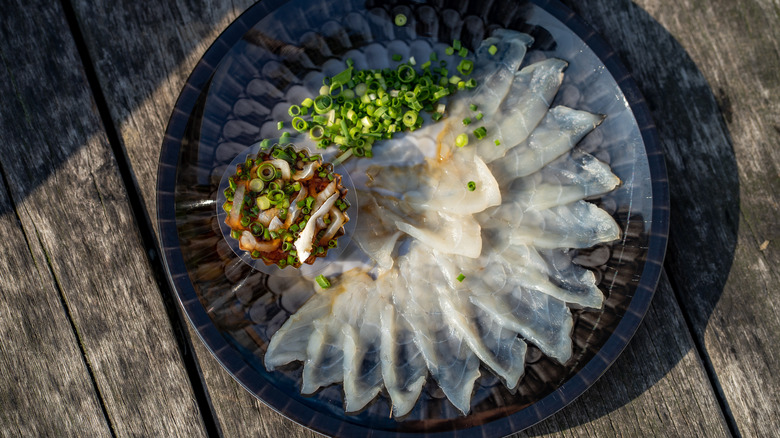The 17 Hardest Dishes To Make From Scratch
Creating dishes made from scratch requires effort, skill, special ingredients, and, of course, time — which many of us don't have in excess. Often, made-from-scratch dishes demand lots of planning and patience. From ostensibly simple soups, to meals and desserts fit for royalty, the most challenging culinary dishes to make can be lofty for even highly trained chefs.
Rare ingredients, arduous instructions, or dishes that need to be watched closely are some reasons they can be challenging from scratch. But don't be deterred — there is hope. Whether you're just getting started on your culinary adventures, or you know your way around the kitchen like the back of your hand, the dishes here will certainly elevate your skill. Of course, these aren't everyday meals — but having one or two up your sleeve for that perfect occasion isn't such a bad idea. Don't be afraid to get creative!
Consommé
To the uninitiated, consommé looks like an unassuming clear broth. But for chefs, even highly trained ones, consommé is a hard soup to master. The foundation for consommé can be simple such as beef or chicken broth — or it can be more elevated by using veal or seafood broths. However it begins, consommé is a time consuming, complicated soup.
The difference between broth and consommé is predominately appearances. Broth is cloudy with visible fats whereas consommé is crystal clear. While the soup should not be cloudy, its origins are — it is said King Louis XIV of France wanted to see his reflection in the soup. However the dish originated, consommé is equated with luxury and fine dining because of the skill required to produce it.
To create, chefs "build" a raft as part of the cooking process. A raft is a mixture of egg whites beaten into soft peaks, a protein of choice, and mirepoix. The stiffened egg whites sit on top of the broth like a little puffy meringue boat, thus the name. The raft absorbs impurities, then is discarded once the solids have been soaked up. The broth is then strained to further absorb any unwanted fat.
While this may seem like a lot of work to make a clear broth, this process is one of the reasons consommé is important as a part of a chef's repertoire. To make a truly beautiful consommé takes time and patience to create a flavorful, clear, rich bowl.
Confit de Canard
Before refrigeration was available, various methods were employed to preserve foods to make them last longer. Confit, a French term, is the process of cooking, then preserving food in fat. When done correctly, meat can last for days or even weeks when kept in a cool, dry place. We do not recommend trying this though — use your refrigerator.
The practice of making confit dates back to the medieval days. The technique of confit preserves proteins or produce between seasons so foods were available off season. Where once confit was essential, now it is a luxurious dish consisting of tender, velvety textured meat.
The process to confit foods involves time, patience and several steps. The first step is a salt rub with seasonings massaged into the protein, then marinated for at least 24 hours. This step forces the moisture out of the meat and infuses the flavors. The protein is rinsed, submerged in oil then cooked low and slow at temperatures from 200-250 degrees Fahrenheit for up to six hours. Cooking the protein slowly at lower temperatures tenderizes it while not losing moisture.
But there's more — if cooking meat such as duck with skin, the final step is to crisp the skin by gently searing, then plate and serve. You can also shorten the cooking time by raising the temperature to 300 degrees Fahrenheit or further shorten the time by Pressure Quacking.
Lou Fassum
Stuffed cabbage is another one of those dishes that has been around for centuries as cabbage rolls, or as a whole stuffed cabbage. Various incarnations of stuffed cabbage recipes date as far back as the 14th century with the Tartars in Eastern Europe, into parts of Scandinavia and the Ukraine. The Jewish Simchat Torah has included stuffed cabbage for more than 2,000 years.
What makes this cabbage dish difficult is not the availability of the ingredients but rather the time it takes to prepare. Lou Fassum utilizes the entire head of cabbage, a "farce" or filling such as ground pork, seasonings, mushrooms, onions, and garlic. Depending on the region, you may also find dried berries or lemon juice soaked raisins included in the farce. In France, the cabbage of choice is savoy because the leaves are beautifully crinkly, tender yet can withstand being bent and folded.
The full head of cabbage is first boiled until the leaves are malleable, then rinsed. The leaves are laid into a bowl where a layer of filling is spread into it. This process is repeated until the filling runs out. Think of making a lasagna but using cabbage leaves. After shaping, the dish is frozen. Several more steps later, including poaching and baking, the dish is served in slices like a big cabbage cake.
Turducken
The turducken — it's three meats in one! Turducken is made by stuffing an entire deboned chicken into a whole deboned duck. This concoction is stuffed into a partially deboned turkey. This football looking mass is held together between the layers with meat glue — yes, you read that right — then wrapped in twine and cooked.
While this dish almost seems like a culinary dare — or something created in Texas where everything is bigger — the dish has a somewhat murky history. Louisiana's Hebert's Specialty Meats in 1985 claims to be the originators of the turducken. The dish was popularized by Cajun chef Paul Prudhomme and NFL football commentator John Madden. Madden notoriously ate turduckens during Thanksgiving football games.
While Hebert's Specialty Meats lays claim to the turducken, the history of stuffed meats dates back to the middle ages. Stuffing one animal into another is a process called "engastration" and is said to date back to the 15th century, with the nightmare inducing cockentrice. The fictional 1,000 pound Trojan boar stuffed with live birds dates back to the Roman Empire. Now those were some difficult dishes to make!
Hot water crust meat pie
Since we're speaking about stuffed birds, our next dishes are extra level for extravagance and decadence. In the world of pies, game pies are quintessentially British. In the Tutor courts, game pies were all about opulence, containing fillings like lamprey eel, swan, peacock, pheasant, or more typically, wild boar. One of the most notorious and demanding to construct game pies is the Tudor Christmas Pie that makes the turducken look easy! To top some of these elaborate pies, a whole swan or peacock, peasants, or other birds were stuffed and placed on top.
Although many of these pie fillings were rarities, it is not only fillings that makes them challenging, but the crust itself. The crust is difficult because whereas most crusts need to be kept chilled as they are being made, hot water crust is made by adding fat (usually lard) to hot water, bringing the mixture to boil, adding flour, then mixing together. As you may have guessed, this results in a sticky mass.
Hot water crust is used because it is thicker, more pliable and sturdy enough to hold dense, heavy fillings like meat and gravy. The more dense dough is used to create game pies that were either free standing or formed into molds, then typically filled with a savory filling. A free standing meat pie is most difficult because there is nothing to support it.
Laminated dough dishes
In the world of pastries and doughs, none is more iconic, delicious or difficult than laminated dough. Laminated dough when done well is flakey, tender and buttery to make croissants, cronuts (a doughnut/croissant hybrid), or slightly easier croissant bread.
Laminated dough doesn't require special ingredients or equipment to make, but it takes time, planning, and, above all, patience. It is the timing that makes laminated dough seem intimidating. It takes three days to make croissants! Don't panic though because much of that time is allowing the dough to chill.
First, baking is an exacting science, so follow your recipe precisely! We suggest a kitchen scale that measures grams and ounces. There are many tips to help you make the best laminated dough but a key is to keep your kitchen and your dough cold. Laminated dough results by folding butter between layers of dough, then chilling. These steps are repeated several times which is partially why laminated doughs are difficult.
There needs to be enough folds to create the lamination, without overworking the dough or allowing the butter to melt while folding. During baking, the butter melts between the layers, expanding them and creating pockets of steam. Once you've accomplished the dough, you're ready for another challenge. Try beef Wellington, or a slightly more complicated salmon Wellington.
Puff Pastry and Choux Pastry
Puff pastry is considered a laminated dough because both are made by layering fat with dough then folding. The difference is puff pastry is rolled until all of the dough is thin whereas laminated dough is kneaded.
Puff pastry is considered less complex because it requires less folds and does not include yeast. The absence of yeast results in a flakier dough best for recipes like Napoleons or mille-feuille, ("a thousand leaves)." What makes puff pastry difficult is the dough should not be over handled, kept chilled, and never, ever roll to the edges. Smushing the edges mashes them together and the puffed pastry won't puff.
Another difficult dough is choux (pronounced "shoo") pastry or pâte à choux, the basis for dishes like croquembouche or eclairs. Choux dough is considered challenging because it is about precision and timing. The ingredients are simple. Milk, butter, sugar, and salt are combined in a saucepan and simmered. Flour is added and mixed together. Eggs are then stirred in until the dough becomes a pipeable consistency. Getting the correct consistency is partially why pâte à choux is tricky.
If you really want a challenge, try Gateau St. Honoré. This impressive dessert combines five elements including puff pastry, choux dough, caramel, and two types of cream. Yikes! If you aren't up for that kind of challenge, grab some frozen puff pastry and make cherry turnovers. We won't tell anyone you used frozen dough. We do too!
Difficult desserts
One of the most difficult dishes to make is a Baumkuchen, a traditionally German cake baked on a horizontal spit. Approximately 20 layers of dough are brushed on a turning spit and can be up to 4 feet long! Not only are there many layers, but each new coating can only be added once the previous layer has cooked. The end result looks like a slice of a tree. Thus the name "baumkuchen" which translates to either tree or log cake. While the basic recipe is primarily eggs, flour, sugar, and honey, this actually is why the cake is an arduous creation — the ingredients must be cooked perfectly so each layer caramelizes.
Speaking of tricky layered desserts, baked Alaska or rainbow baked Alaska is one of the most difficult. Nothing says challenging like a frozen dessert that is lit on fire! During the 1950's, baked Alaska was popular but like most trends, fell out of fashion. The dish's popularity has reemerged with searches for recipes increasing 200 percent in 2021.
It is thrilling to sit tableside when a waiter sets a towering meringue mountain aflame — but the real magic is how the whole thing doesn't melt into a sad blob. How does a dessert made from layers of ice cream stacked on cake not melt? Actually, it's science! In simple terms, the layer of meringue works like attic insulation, using whipped egg pockets to create a heat barrier.
Gelatin Meats: aspic and galantine
Because we haven't talked enough about stuffing meat into other things, a galantine is yet another example. What makes a galantine different from a confit, but equally difficult is once the prepared dish has been poached, it is allowed to gel in the poaching liquid and served cold. The dish can be served warm, but is called a ballotine. Either sounds delicious right?
The jellied part of a galantine is called an aspic which was popularized in America by Julia Child. Aspics and gelatins remained popular throughout the '50s and '60s with dishes like terrine. American housewives were suspending a range of ingredients in gelatin from the infamous pear and carrot green Jello, main courses of head cheese which is not cheese or tuna casserole with cottage cheese.
If you've ever made a Jello mold, you already know it is fairly simple to make theoretically. But when the gelatin doesn't set right, it's a mess. Where instant gelatin can go wrong, aspics amp up the difficulty because the dish relies on using a clarified stock the same as a consommé. A successful aspic should wobble, but you should also clearly see all of your shrimp and hard boiled egg salad. Every tasty suspended morsel of the dish should be visible in crystal clear gel. Unlike the cottage cheese tuna nightmare combinations of the '60s, aspic has returned to popularity and been elevated, being used as an art form and as a method to reduce food waste.
Rice dishes -- paella and risotto
While rice is a staple across the world, it can sometimes trip up a cook. Chef Aarón Sánchez, famous Latin celebrity chef on shows like "MasterChef," "Chopped," and "The Next Iron Chef" says risotto can be tricky because it must be closely watched and takes time to get the correct consistency. If you watch shows chef Sánchez judges, he knows what he's talking about — even professional chefs trip up while attempting risotto under time restraints. The main reason risotto can go awry is not giving the dish time to allow the rice to come together in liquid, and not over stirring it.
Paella with shellfish is another popular rice dish that can be challenging even for professional chefs. Paella should be made in a large, flat pan. The rice should be allowed to form a crust on the bottom toward the end of cooking. This is achieved by turning up the heat and not stirring the dish. It is this crust formation that is difficult. With patience and care, perfect paella can be achieved. Even with care though, a burnt bottom is always a possibility when creating paella.
Chiles en nogada
Chiles en nogada is a tasty dish made by stuffing poblano chilis with a pork and beef based picadillo, coated with a nodaga, or white sauce made from walnuts, then topped with parsley and pomegranate seeds. The dish is made to represent the Mexican flag and mostly served during Mexico's Independence Day in September. It is also available throughout August into early October in some regions.
What makes chiles en nogada a difficult dish is based partly on the ingredients, but primarily it is the production of the dish that is challenging. In Yuriria, a municipality in Baja, they traditionally include candied cactus (biznaga) which adds a level of difficulty. Biznaga can be substituted with other candied or dried fruit.
To make chiles en nogada, the picadillo is first prepared which consists of chopping and cooking the proteins, chopping the produce, then roasting the peppers to create a gorgeously grilled and charred skin. The peppers are deseeded after removing the skin. The nodaga sauce is also prepared. After gently stuffing the poblanos, smother with the walnut sauce, garnish with pomegranate seeds and parsley, then serve. Chiles en nodaga takes time and love to prepare but is worth the effort!
Let's taco 'bout it
If we had our way, everyday would be taco day. There is almost nothing more delicious than a great taco from our favorite local joint. Tacos aren't typically considered a difficult dish to create, but the truly good ones take considerable amounts of time and effort to create like barbacoa, or machaca beef. These preparations take hours of low and slow cooking to achieve the moist, tender and mouth watering fillings for tacos, chimichangas, or enchiladas. If you don't have the time to slow cook meats, ground beef is always a tasty alternative.
Another time consuming, but excellent filling is chilorio. Chilorio is made by combining primarily shredded pork, various spices, and apple cider vinegar. The dish hails from Sinaloa, Mexico where it is sold in markets pre-made or canned. Since Sinaloa is on the coast, grilled marlin is not uncommon but is more difficult to procure in the United States. Shrimp or other fish are also commonly used as part of chilorio. Pork adobo is a similar dish using pork shoulder, but is considered more common in the Philippines. Both adobo or chilorio may take time to prepare but are worth every minute.
Pasta dishes
Homemade pasta may seem daunting to make because many things can go wrong like overworking the dough, or over or undercooking your pasta. Fear not, homemade pasta is easier than you think! The ingredients to make pasta are uncomplicated and items you should always keep stocked in your kitchen: flour, salt, eggs, and water will get you well on your way to an amazing meal.
While pasta alone can be challenging, cooking recipes like Pasta Cacio E Pepe, which translates to "cheese and pepper" can be difficult if not given time to prepare. The dish consists of pasta — typically long noodles like spaghetti or linguine — with a cheese sauce. What makes cacio e pepe tricky is the attention to timing and details required. The pasta should be cooked al dente, and the cheese sauce needs to be stirred until it emulsifies. Once the pasta is cooked, add the noodles to the sauce, gently stir together, plate and serve.
Ragù Napoletano takes a lot of time and patience to create. Ragù Napoletano is, at its heart, a meat and tomato sauce. The sauce is cooked at such a low heat that it doesn't simmer and is allowed to cook for hours. It's finished when tomatoes and oils have separated and cooked for at least an hour like this. The sauce is actually better prepared ahead of time because the flavors get to settle in together – it can be made days in advance.
Tricky sauces
A good chef or home cook should have a few sauces in their repertoire. Classic sauces to know are espagnole which is a basic brown sauce, and Hollandaise. In French cuisine, there are five primary sauces, called mother sauces. These are the basis for dishes like gravies, scalloped potatoes or ragù napoletano. Tomato sauce is also considered a mother sauce.
Mother sauces aren't necessarily difficult to make — and most of the ingredients are kitchen staples — but again, it's about giving sauces the time needed to allow them to really come together in all their glory. Espagnole, a brown mother sauce from brown stocks like beef, is based on a brown roux. Making roux can be a bit complex. Although it is made of only flour or cornstarch whipped into melted butter, this can trip up cooks. A roux needs to be whisked until it is shiny and glossy without any lumps. Without careful attention, a roux can burn, resulting in a bitter taste.
Rouxs are also the foundation for béchamel, the classic white sauce used to make cheese soufflés or homemade mac and cheese. When a roux is left cooking longer than a brown roux, it becomes a black roux which is most commonly used in gumbos or étoffees. Due to cooking time, black roux (typically for Cajun and Creole dishes) is also the most difficult to cook because it comes to the brink of being burnt.
Most time consuming soup
While there are many soup recipes that require significant amounts of time to prepare, the one that stands out is Buddha Jumps Over the Wall Soup. Also known as Buddha's Temptation or Fotiaoqiang, Buddha's Temptation is a luxurious Chinese delicacy that can take at least two days to prepare. The dish requires upwards of 30 ingredients including abalone, duck, tripe, scallops, pigeon or quail eggs and various types of ham. Some recipes will include silkie chicken which has a black skin and white feathers. The black fowl will sometimes be served whole in the soup to showcase the bird.
It is not only the long list of ingredients, but some like the abalone or shark fin need to be prepared the night before. Once the actual construction of the dish begins, it is a two day process including grouping them together into three different dishes. This step allows flavors to develop. The ingredients are then layered together in a clay pot with stock and wine, covered with lotus leaves and cooked for four hours.
Legend says a traveler scholar kept his food in a clay pot. During a stop to cook his food near a Buddhist temple, the smell of the cooking soup was so tantalizing that the monks jumped the temple walls although they are vegetarian. A monk or poet said "even Buddha would jump the wall" to taste the magnificent dish.
Century eggs
Century eggs have one of the strangest origin stories for a food item. The stories vary, but the most prevalent one says a Chinese farmer during the Ming dynasty discovered duck eggs that had been covered in lime mud. He tasted them, and liking the flavors of the blackened, sulfur smelling egg, he recreated the recipe. Not only is the process to replicate this dish unusual, so is their smell, appearance and taste.
Sometimes called a 500 or 100 year egg, the eggs are time consuming and difficult to make. Using duck, quail, or chicken eggs, the eggs sit in a mixture of alkaline, clay, wood ash, quicklime, and slaked lime. After coating the eggs with this mud, they are wrapped in husks and packed away for months. The result is a jelly-like black, brown, or green egg with a sulfur smell.
Century eggs are quite healthy. The dish contains higher protein than a regular chicken egg, has less carbohydrates, can help reduce blood pressure, improves liver performance, as well as a host of other benefits. If you would like to sample these eggs for yourself but don't want to attempt the process to make them, you can find a variety at many of your local Asian markets.
Living dangerously
Fugu, a Japanese delicacy made from a puffer fish, is so extremely difficult to make that the dish is regulated in Japan. In America, the Food and Drug Administration (FDA) has an advisory, warning restaurants and fish markets to obtain puffer fish from only known (safe) sources. Preparing fugu is challenging because the ovaries and liver contain most of the toxin. If either are punctured, poison can be released throughout the remaining fish. The flesh is filleted sashimi style. Diners have been served the testicles, but this is also when the majority of fugu poisonings have occurred. Fugu is incredibly demanding to create — but because the thrill of eating something that could kill you is intriguing to some people, fugu is an exorbitant luxury.
Never make fugu yourself at home! Since 2000, Japan has reported 23 fugu-related deaths. Most of those deaths resulted from those who caught and attempted to prepare the fish at home. In the United States, both recreational and commercial operations catching puffer fish is allowed in some states like Rhode Island or Florida. There are various types of puffers, and not knowing the difference can be deadly. Only trained chefs should prepare fugu. The poison in a puffer fish is more toxic than cyanide. If done incorrectly, serious illness or death can result.

